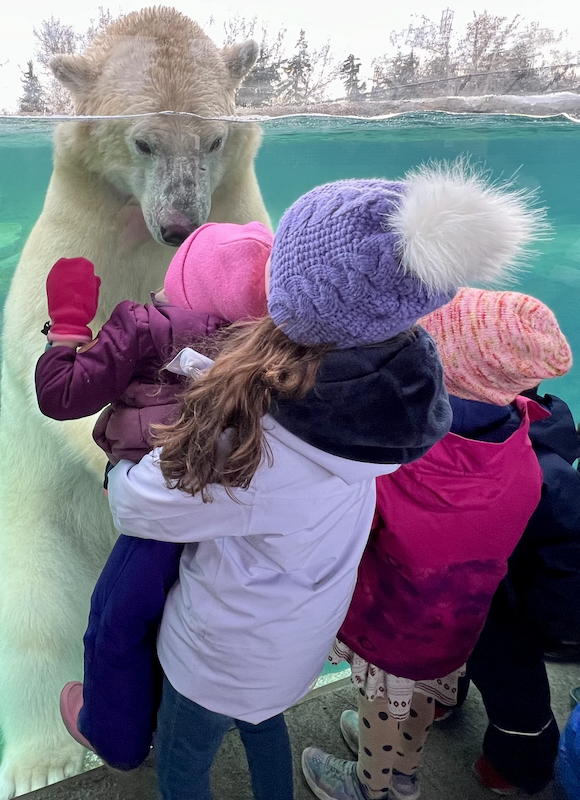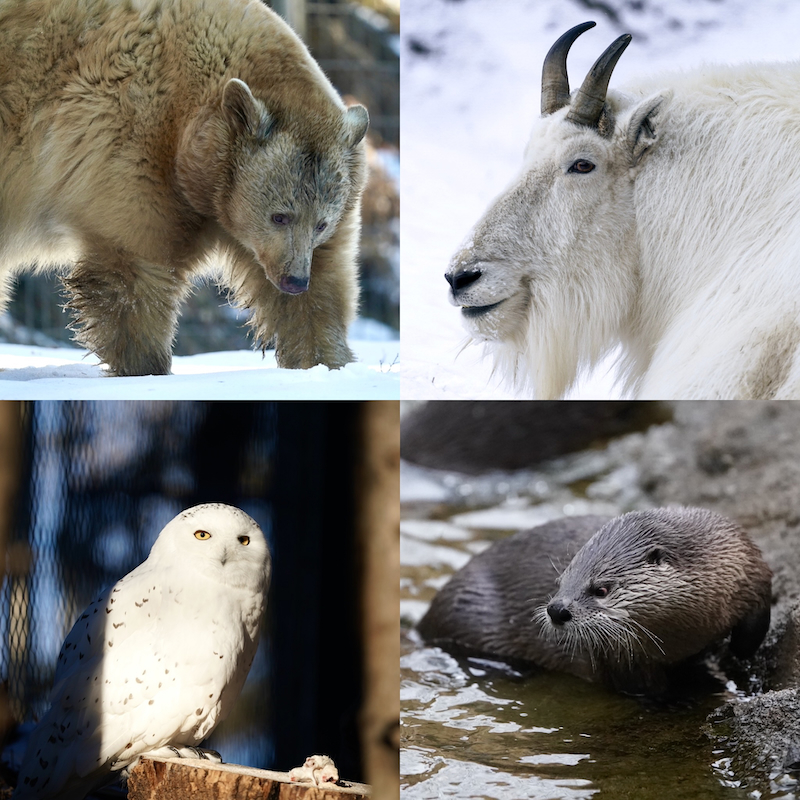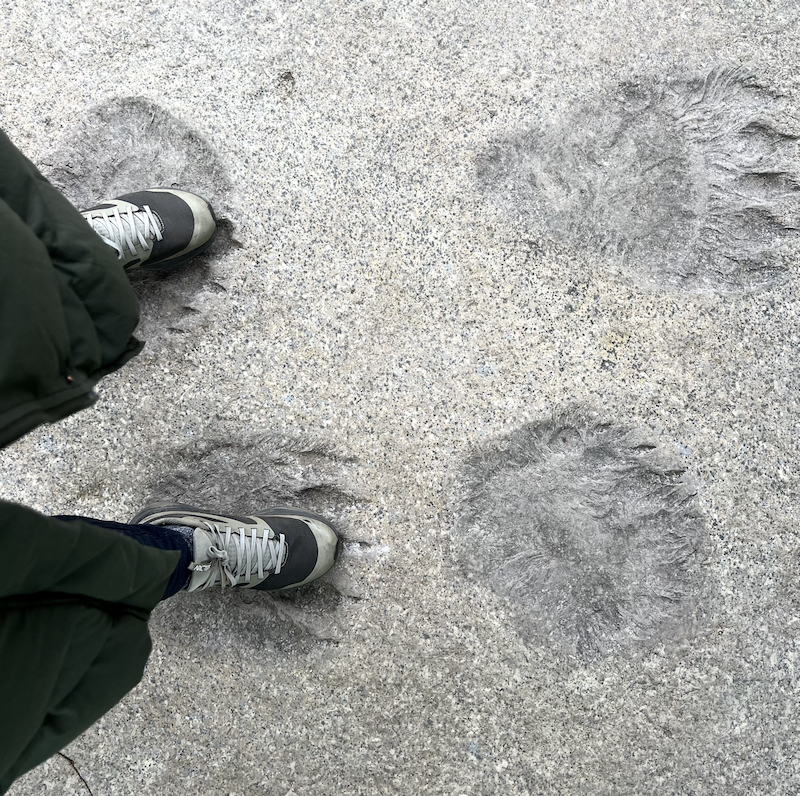Editor’s note: This post is the result of an arm’s-length collaboration with the Wilder Institute/Calgary Zoo.
By Kim Gray
I’m standing before the window of a polar bear plunge pool amidst a swirling sea of invited media, including moms with baby strollers and toque-clad children, and I can tell you one thing for certain: this empty nester is missing her little people.
My husband and I practically raised our daughter and son at what is now known as the Wilder Institute/Calgary Zoo.
Today, our children are grown, chasing love and careers on Canada’s West Coast, but there was a time when this cherished destination was central to our lives as a young family.
I wish my kids were with me now at this extraordinary sneak peak of Wild Canada, a $42 million re-development of what was once known as the zoo’s “Canadian Wilds” section and an audacious example of how the organization continues to evolve.
The superstars of this 21-acre space — now open to the public and featuring seven ecological zones and 17 Canadian species — are two male polar bears, Siku and Baffin, who arrived in October 2023.
Both bears were moved here from Winnipeg’s Assiniboine Park Zoo and were originally rescued from northern Manitoba as orphaned cubs, too young to survive on their own in the wild.
To the delight of his audience, Baffin is putting on a plunge pool show to remember — a reminder that the polar bear, scientifically referred to in Latin as Ursus maritimus or “sea bear,” is a marine animal (with slightly webbed paws) known to swim for days at a time in its arctic environment.
Baffin blows bubbles the size of small balloons from his nose, summersaults effortlessly and then soars to the surface of the water only to dive back down with surprising speed and grace.
The bear’s high-energy antics are met with waves of shrieks and gasps from his audience.
He also swims right up to the plunge pool’s viewing window, returning the gaze of the young children standing wide-eyed before him.

Baffin swims up to Wild Canada’s polar bear plunge pool window, delighting the young audience before him. Photo by Kim Gray
It’s nothing if not moving to experience, much less witness, such a tender gesture from the planet’s largest land carnivore. But from what I gather, this is the point.
What I’m saying is that when I interview Lauryn Record — senior strategist with interpretive planning and creative services at the zoo — she insists that one of the main goals with Wild Canada is to get people “to connect emotionally” with wildlife.
More traditional interpretive programs, says Record, hyper-focus on facts and science.
Wild Canada goes beyond the sharing of facts and science with multiple interpretive approaches — including immersive design, Indigenous storytelling and art exhibits — to deepen the visitor experience.
Emotional connection to the animals and their landscape, Record explains, nurtures empathy, which in turn fuels action.
“The species we care for are ambassadors for those places in nature where they normally exist,” she continues. “The only way forward for wild places is for humans to care for them. We are the change-makers.”
She wants to help zoo visitors connect “to the bigger picture,” reminding them that these remarkable animals live in our backyard, that it’s a privilege for us humans to live alongside them in Canada and that we’re all responsible for their stewardship.

Wild Canada features 17 Canadian species and seven ecological zones, shaped “to transport visitors to iconic Canadian landscapes.” Photos by David Gray
“We shaped the Wild Canada experience to transport visitors to iconic Canadian landscapes. Instead of visiting a Rocky Mountain goat habitat, you’re venturing into the Rocky Mountains. The otter habitat is intended to feel as though it was carved by the Bow River and the polar bear habitat feels like you’re in the arctic tundra,” Record explains.
I’m encouraged to learn that Baffin and Siku’s new habitat, according to Wild Canada’s animal care manager Patrick Thompson, will give the zoo’s new residents multiple opportunities to exhibit natural behaviours.
“They like to get high and see the horizon and they need a lot of stimulation,” he says.
“We have plunge pools for them but also water features that they can activate, including a deep soaker shower, pillars that shoot out mist that they can walk through and one feature that is much like a spray park for kids, but with bear operated doors.”
Recent efforts being made at the Wilder Institute/Calgary Zoo, according to Laura Glick, manager of conservation education, are part of a planet-wide movement to inspire conservation champions and help the world thrive.
“Why should people support the zoo?” she asks. “It gives visitors an opportunity to be awed by wildlife and nature. People come and have magical moments and these can turn into a lifetime of love for nature.”
No question, the conservation-minded people behind Wild Canada have lofty goals, with programming designed to “educate visitors about the importance of biodiversity, the impacts of climate change and the complex survival challenges facing iconic Canadian wildlife and wild spaces.”
As a long-time supporter, I’m impressed by the zoo’s ambitions to restore balance between “wildlife and human life, together.”
I also like learning that it currently boasts 88,000 memberships, demonstrating that Calgarians continue to appreciate and support the organization.
I’m remembering my husband and I as sleep-deprived new parents who found welcome respite here so many years ago.
The zoo in Calgary was a place to stretch our legs and socialize with other young families. The fresh air was always welcome and so, too, was the fact that our energetic young kids had a safe place to run free.
Of course, being surrounded by the riches of the animal kingdom was also integral to the picture.
Given my experience with Wild Canada, it seems there’s even more on offer to visitors at the zoo these days: a deep call, one that lingers, to consider our own place in the wonder of things.

The author steps into polar bear footprints, the size of large dinner plates, on display at Wild Canada. With its slightly webbed paws, the marine animal is an ace swimmer. Photo by Kim Gray
Note to readers: The Wild Canada zone redevelopment project was made possible thanks to investments by the Taylor Family Foundation, Brawn Family Foundation, the Government of Canada – Canadian Heritage and Prairies Economic Development Canada, the Province of Alberta, the City of Calgary and many generous donors, funders and partners.
Toque & Canoe is an award-winning digital platform featuring stories about travel culture in Canada and beyond. Follow us on Twitter/X, Instagram and Facebook.

